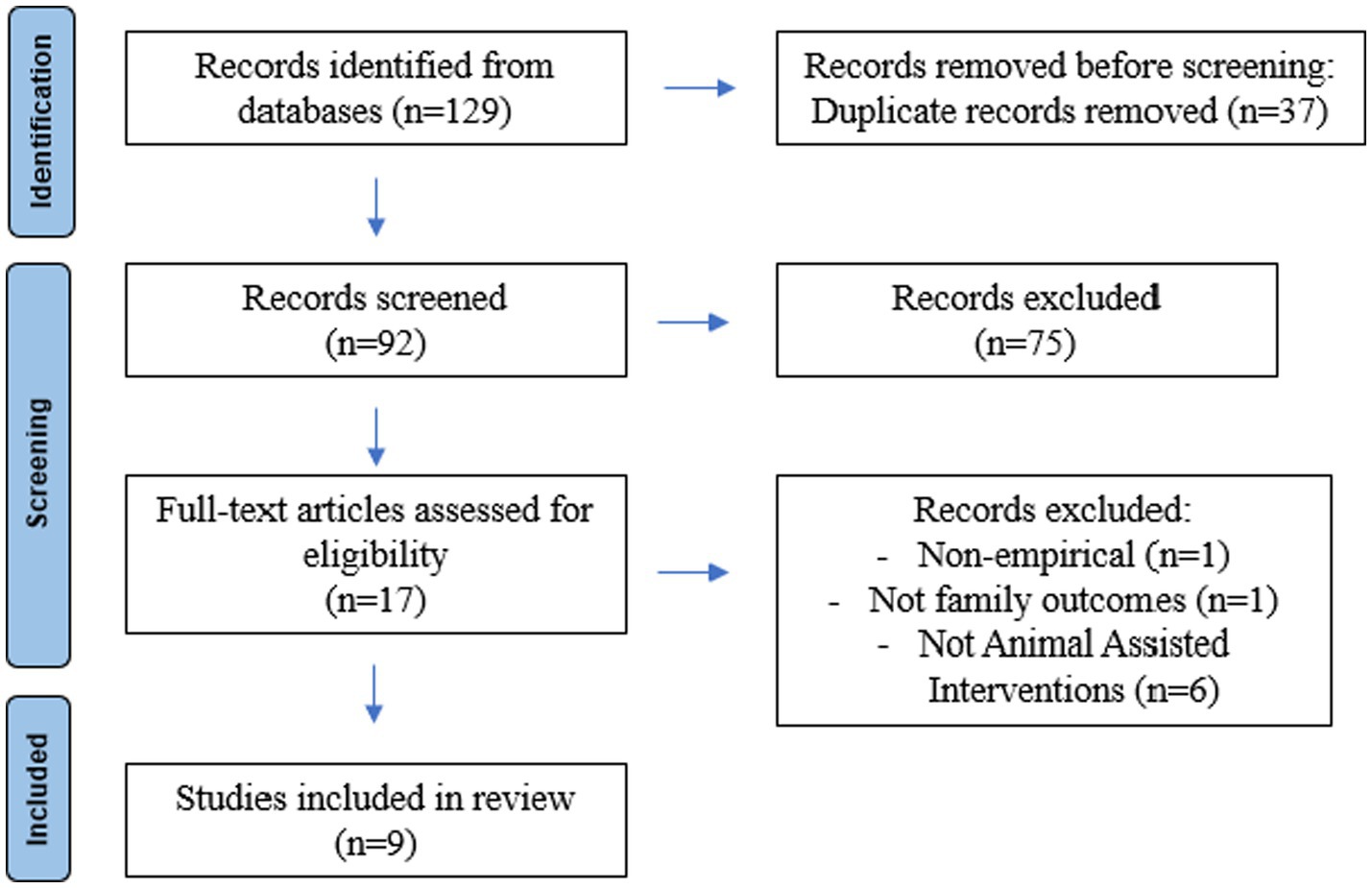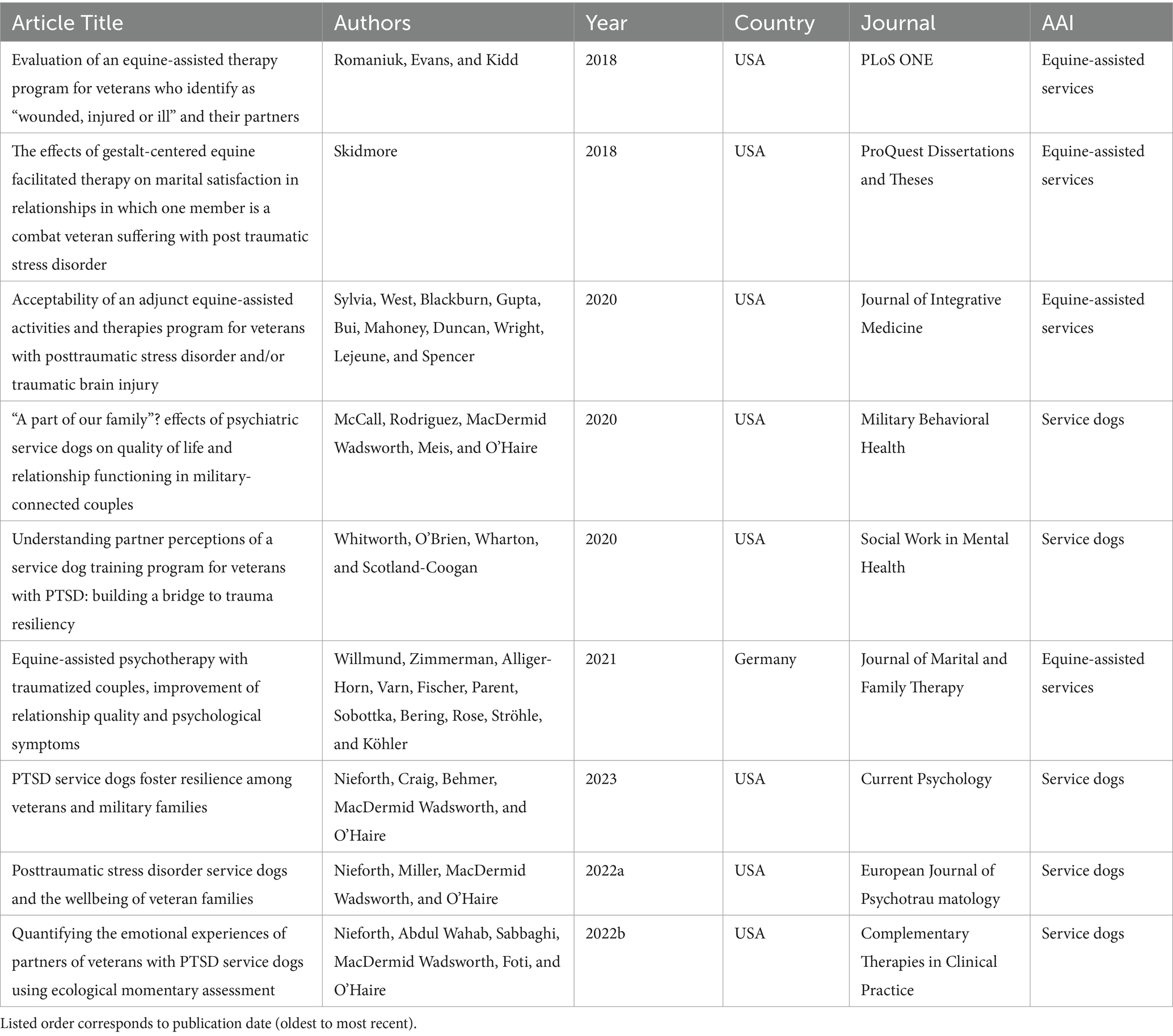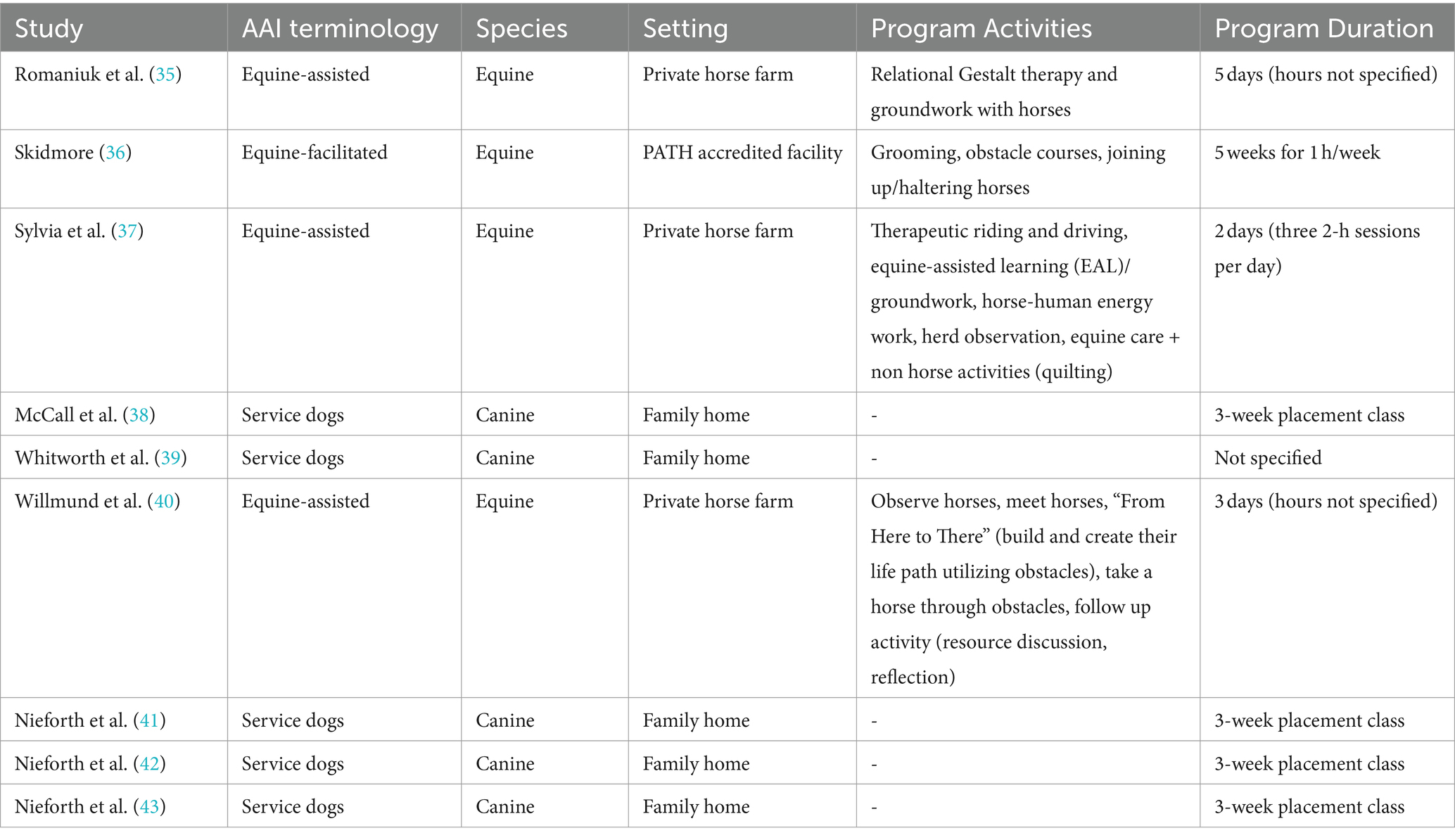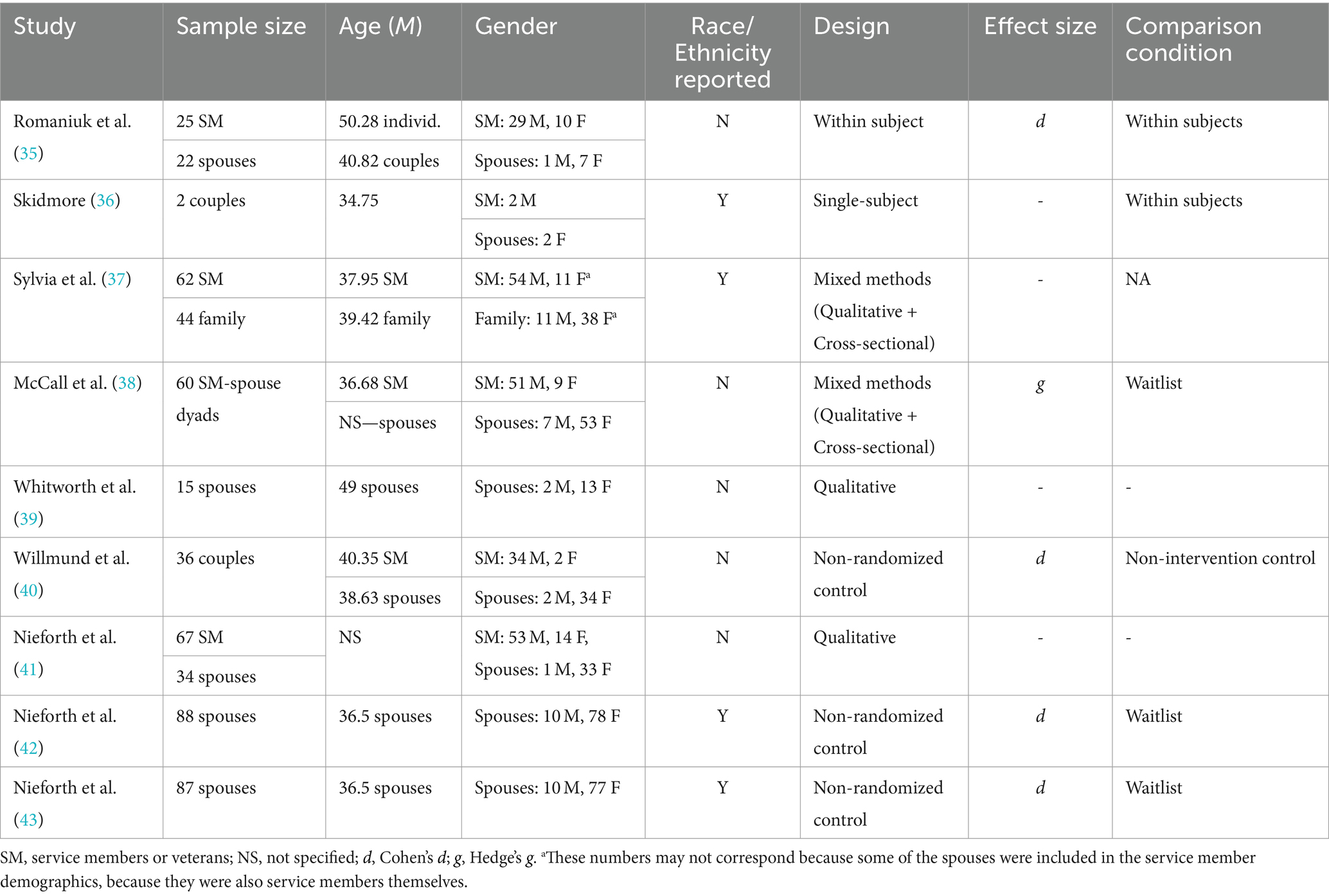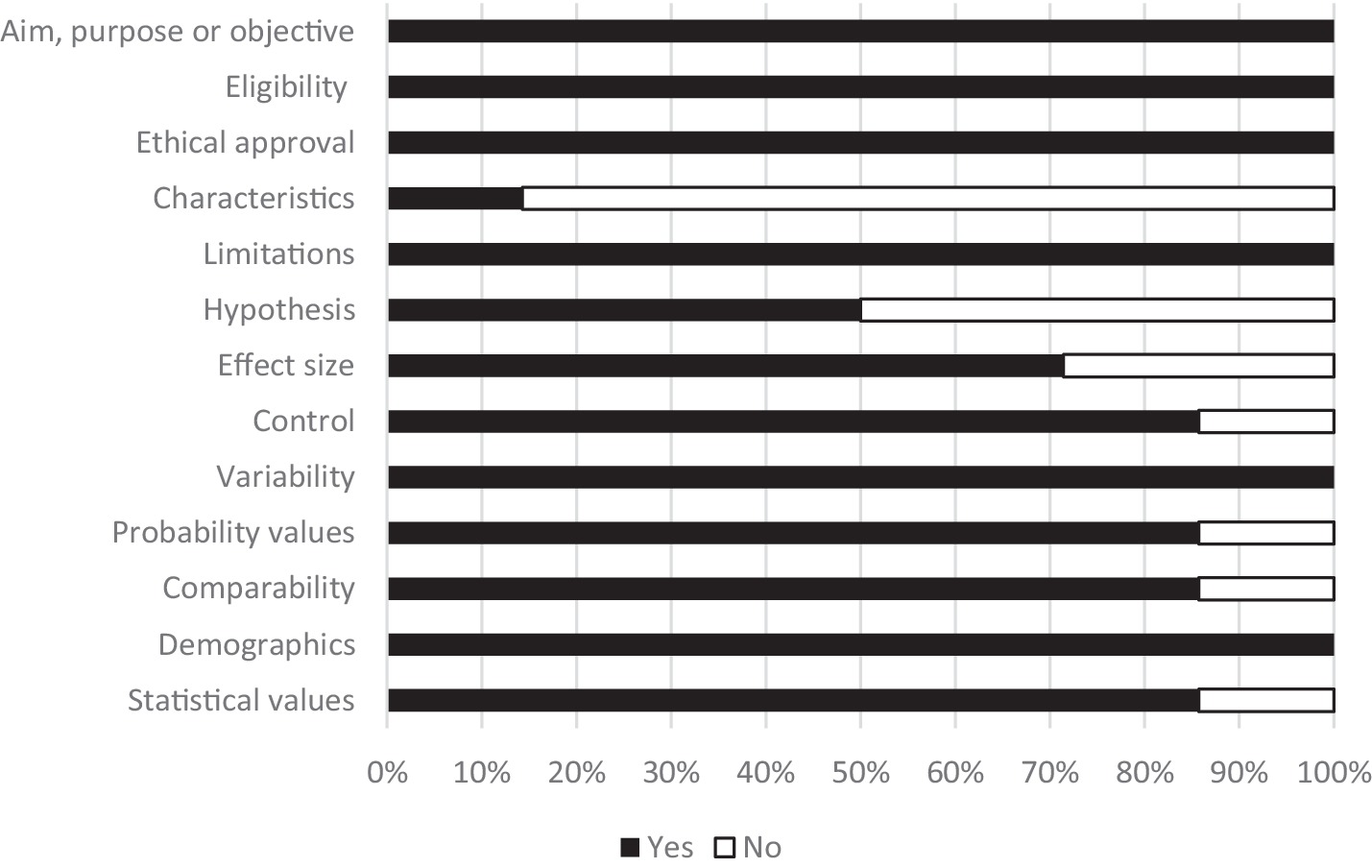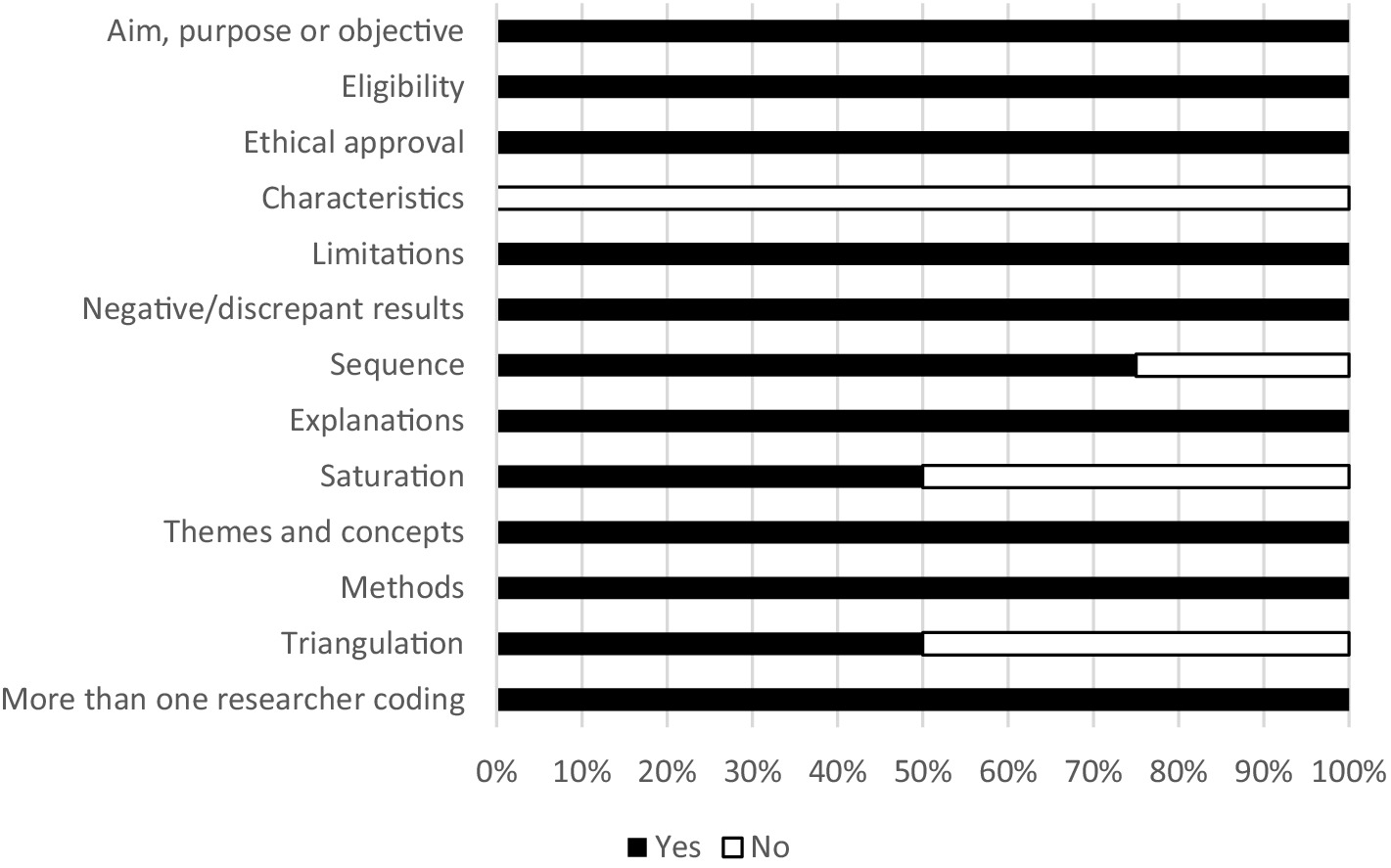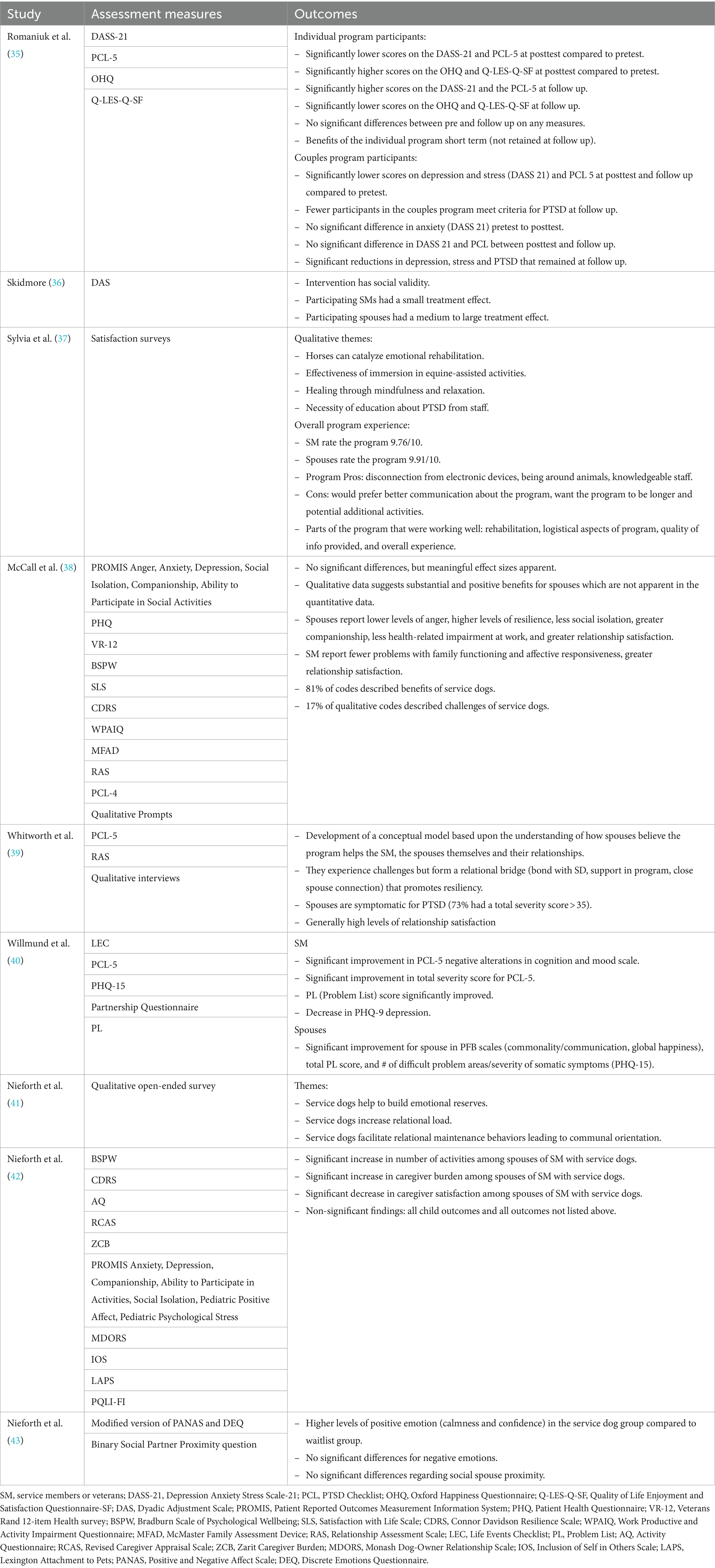- 1Department of Comparative Pathobiology, Purdue University, West Lafayette, IN, United States
- 2Department of Psychology, College of Science, University of Arizona, Tucson, AZ, United States
- 3College of Veterinary Medicine, University of Arizona, Tucson, AZ, United States
Introduction: The incorporation of animals into interventions focused on military families is a relatively new concept. Though animal-assisted interventions (AAIs) have been studied in the context of military veterans, few studies incorporate members of the military family or focus on the family members’ experiences.
Methods: This systematic review investigates the effects of AAIs on the wellbeing of military family members beyond the veteran themselves through three aims: (1) by describing the characteristics of AAIs for military family members, (2) by evaluating the quality of the methodology present within the current literature, and (3) by identifying key concepts and knowledge gaps within the findings reported to date.
Results: A total of nine articles met the criteria to be included in the review. Though the inclusion criteria and search terms included all types of animal-assisted interventions, the only interventions represented were service dogs (n = 4) and equine-assisted services (n = 5).
Discussion: Findings suggest AAIs could be beneficial in areas such as communication, relational bonds, and psychosocial well-being. Though additional research is necessary, AAIs may be an effective complementary intervention for military families.
Introduction
Military families—a service member or veteran of the armed forces and their immediate family members—may be at risk for a multitude of concerns both inter- and intra-personally. The training and subsequent military service of the service member or veteran (hereafter, veteran) may each lead to significant emotional and mental health changes and challenges for both the veteran and their families (1, 2). As a result, family-focused interventions may be particularly effective in promoting mental and physical wellbeing and resilience in the context of military families (3). One category of complementary intervention that shows promise for military families is animal-assisted interventions (AAIs).
AAIs are defined as “any intervention that intentionally includes or incorporates animals as part of a therapeutic or ameliorative process” (4, p. 25). According to prior research, the human-animal bond that may develop during AAIs shares similarities with attachment bonds, potentially contributing to the effectiveness of these interventions (5, 6). This bond may serve as a crucial component of the therapeutic process (7). While a wide variety of literature has explored the impact of AAI for veterans [see recent reviews; (8–10)], much of the literature that has included measures of family-wide impacts has done so solely from the perspective of the veteran. The veteran’s experience may or may not align with the experiences of other family members; therefore, there is a need for studies that are designed and powered to collect data directly from military family members other than (or in addition to) the veterans themselves.
Experiences of military spouses and partners
Within a close intimate relationship, the experiences of one person can also impact the other person. This is particularly true for spouses or partners of veterans due to some of the unique aspects of military service (11, 12). These unique aspects can include any combination of the veteran’s military training, deployment, combat exposure, and transition back into civilian society. During a veteran’s deployment and reintegration period, spouses and partners (hereafter, spouses) of veterans may experience psychological, logistical, and economic challenges (13, 14). Psychological challenges may include (1) supporting their veteran spouse through new physical and mental health challenges and (2) potentially also managing their own depression, anxiety, sleep disturbances, secondary posttraumatic stress, and/or suicidal ideation (15–19). These challenges may be of greater concern for spouses of veterans as deployment length increases (19). Additionally, due to the veteran’s periods of absence for military activities and forced relocation for different assignments, spouses of veterans commonly experience isolation. Frequent relocation can also create difficulties for career and identity development (12, 16). Periods of transition back to civilian life can be particularly challenging due to the change in communities and separation from the support of other military families on base (12, 16). Community social support has been shown to be an important protective factor among military families, and spouses can benefit from support to help develop new coping skills and behavior patterns (12, 20).
Experiences of military children
Recent literature has identified a great need to recognize the experience of military-connected children and provide added support to promote their wellbeing (21). While experiences of military-connected children vary, they may include both positive and negative aspects. For example, some military-connected children experience challenges with social, behavioral, and mental health (3). If their parent’s military service takes place during childhood, separation from the parent (due to trainings or deployment) and frequent relocations have been shown to lead to decreased school performance, decreased mental health and decreased social supports (2). If a parent has been injured in combat, children may also have increased psychological concerns, with a higher incidence of mental health visits, injuries, and maltreatment (22, 23). A systematic review of the influence of a parent with war-related posttraumatic stress disorder (PTSD) on children around the world suggests that as a result of the parent’s PTSD, children may experience secondary traumatic stress, other mental health concerns, and relationship issues as adults (24).
Intrafamilial relationships
Throughout the entire military experience from pre-deployment to reintegration, family functioning and relationships are critical to family wellbeing and resilience (25). Family functioning can also be negatively affected by the veteran’s separation from family for extended periods of time leading to a broader lack of connection (25). Furthermore, such a lack of connection may have negative effects on marital quality, relationship satisfaction, and the mental health of all military family members (26). Communication patterns, relationship quality, and parenting may also be impacted by the psychological distress of the veteran (12, 27, 28). On the other hand, effective and consistent communication among military families may be a protective factor for reducing deployment-related stressors (29). Experiences of economic strain may also impact the functioning of military families [(e.g., 13, 30)].
Each family is unique, and the specifics of military culture and service may vary. However, overall, military families experience unique stressors and opportunities for growth compared to non-military families. Military families may face significant challenges resulting from military culture and military-related activities and, in the face of these challenges, many military families demonstrate significant resilience, effective coping skills, and posttraumatic growth (14). It is critical to recognize that military families experience both negative and positive effects resulting from training, deployment and reintegration, and therefore need targeted supports to bolster their wellbeing (14). It is well known that throughout their military involvement, veteran and family members’ experiences are directly impacted by social support and positive family relationships (2, 31). Family-focused interventions may be particularly effective given that they emphasize family relationships and social support strategies such as effective communication, awareness, understanding, and psychoeducation (32). Notably, it has been suggested that social support theory may be a key mechanism through which AAIs promote change, indicating strong potential for their effectiveness for military families (33).
To synthesize the existing literature related to the influence of AAIs on military families, we conducted a systematic review. Given the potential discrepancies between the veterans’ own experience and that of their family members, the present review was focused solely on studies which collected data directly from military family members other than (or in addition to) the veterans themselves. The research question was “What are the effects of AAIs on wellbeing of military family members?” Our first aim was to describe the characteristics of AAIs for military family members. Our second aim was to evaluate the quality of the methodology present within the current literature. Our third and final aim was to identify key concepts and knowledge gaps within the findings reported to date.
Methods
We conducted a systematic literature review in accordance with PRISMA guidelines. A total of five databases were searched from their inception date to 1 March 2023 (ERIC, ProQuest Research Library, ProQuest Dissertations and Theses, PsycINFO, PubMed, and Scopus). In addition, the Human-Animal Bond Research Institute (HABRI) Central Database and the Journal of Veteran Studies were hand-searched for relevant articles. Search terms included a term for military families and a term for animal-assisted or pet. The terms for military families included: military and/or veteran families/spouses/partners/children/couples. The terms for animal-assisted/pet were adapted from a previous AAI literature review (34), and included: animal intervention, animal therapy, animal assisted, animal facilitated, anthrozoology, assistance animal(s), assistance dog(s), assistance horse(s), canine therapy, canine assisted, canine facilitated, companion animal(s), dog therapy, dog assisted, dog facilitated, dolphin therapy, dolphin assisted, dolphin facilitated, equine therapy, equine assisted, equine facilitated, hippotherapy, horseback riding, human animal bond, human animal interaction(s), pet therapy, pet assisted, pet facilitated, service animal(s), service dog(s), service horse(s), therapeutic animal(s), therapeutic dog(s), therapeutic horse(s), therapeutic horseback, therapeutic pet(s), therapeutic riding, and therapy with animals. Specific search formatting was adapted according to the syntax rules for each database. While this review was not pre-registered, the protocol was developed in advance, prior to conducting the database search.
Inclusion criteria for articles included:
1. Publication in English in a peer-reviewed journal or as a dissertation
2. Collection of empirical data on AAIs
3. Reporting of outcome results for military families, directly from family members other than the veteran
Exclusion criteria included:
1. Not published in English
2. Literature reviews/meta-analyses
3. Validation of a measure
4. Book review or book chapter
5. Magazine article, commentary, or editorial without empirical outcomes
6. Conference presentation, abstracts, or posters
7. Reporting family outcomes only from the perspective of the veteran (i.e., no collection of data directly from other family members)
Both authors conducted an initial screening for inclusion based on titles and abstracts. Selected articles were then read in full by both authors to make a final determination (Cohen’s Kappa = 1.0). Disagreements were resolved through discussion. Article screening flow is presented in Figure 1. Both authors independently coded 20% of the articles to establish adequate inter-rater reliability. Finally, the first author (LN) coded 100% of the articles.
Methodological rigor was assessed adapting binary (yes/no) scoring questions from a previous human-animal interaction review (see Supplementary Material) (9). Questions focused on transparency of study methods (e.g., Was the aim of the study stated? Was there a clear description of participant eligibility? Was ethical approval attained?); the study design (quantitative, qualitative, or mixed methods) dictated the applicable methodology-specific questions.
Results
To date, nine articles have been published that specifically collected data focused on AAIs directly from military family members (Table 1). Four articles (44%) focused on the influence of equine-assisted services (EAS) for military families and five (56%) focused on the influence of service dogs on military families. Three of the five articles focused on service dogs were from the same clinical trial, each reporting on a different data stream of the parent trial. None of the articles that met our eligibility criteria for inclusion included AAIs with animals other than horses or dogs. One of the articles (11%) was an unpublished dissertation. Eight of the nine articles (89%) reported findings from studies that were completed in the United States, and one that was completed in Germany (11%). The articles were published in a range of interdisciplinary journals. The earliest article was published in 2018 and the most recent in 2022 with seven of the nine articles (78%) published within 3 years prior to the search being conducted.
Aim 1: Characteristics of AAIs for military family members
The nine included articles (4 focused on EAS, 5 on service dogs) represent seven different studies focused on military families and AAIs (Table 2). Three out of the four EAS studies (75%) took place at private facilities. The fourth study took place at a Professional Association of Therapeutic Horsemanship (PATH) accredited facility. Activities within the EAS programs covered a broad range, but most were non-riding related programming (75% of studies). Program duration ranged from 2 days to 5 weeks and the total contact hours were unclear.
Given the nature of service dog partnerships, in that the service dog lives alongside the military family, the setting for each study incorporating service dogs was in the family home. Aside from the initial placement program (e.g., 3-weeks intensive pairing and training process at the service dog provider’s facility), there were no planned program activities nor reported duration for the service dog interventions. This is expected given the nature of the service dog intervention; the service dogs are trained in specific tasks to mitigate the handler’s symptoms and fully integrated into the handler’s daily life until the time of the service dog’s retirement or death.
Aim 2: Quality of methodology
The sample size of articles ranged from 15 to 120 participants (M = 71.11, SD = 40.73). Five articles (56%) incorporated both the veterans and the spouses, and four articles (44%) only included spouse participants. No articles collected data directly from military family children. The average age across all articles that reported participant age was approximately 39.64 years old (SD = 5.01). Excluding Sylvia et al. (37) (where participants could have been counted twice if both a veteran and a spouse), across all articles, there were approximately 330 individuals who identified as female (58%) and 204 who identified as male (42%). Only four articles (44%) reported on race and/or ethnicity. Six articles (67%) were longitudinal and used survey measures. Three articles (33%) were cross-sectional and used survey measures. One of the cross-sectional articles (11%) also incorporated qualitative interviews. All the articles that methodologically could have reported an effect size did so. Two articles (22%) reported results from studies using within-subject designs, three articles (33%) reported results from studies employing a waitlist control group and one article (11%) reported results from a study employing a non-intervention control group (Table 3).
Analysis of methodological rigor identified strengths of the current literature as well as areas for growth. All quantitative studies stated variability, limitations, demographics, ethical approvals, aims and eligibility. Six out of seven quantitative studies stated comparability of baseline characteristics, statistical values, probability values and the control group. Five out of seven mentioned effect sizes and fewer than half of studies explicitly stated a hypothesis or characteristics of the animals incorporated into the intervention (Figure 2). All qualitative studies stated aims, eligibility, ethical approval, coherent explanations of findings, clear methodology, limitations, clear themes, incorporated more than one researcher into coding and considered negative/discrepant results. Three out of four incorporated sequences from the original data set. Half of qualitative studies discussed achieving saturation and the triangulation of data. No qualitative studies mentioned the characteristics of the animals incorporated into the intervention (Figure 3).
Aim 3: Key concepts reported to date
Across manuscripts there were a wide variety of measures used to assess military family wellbeing. Based on findings reported in the articles, negative impacts from the AAIs were minimal. The most commonly used measure was the PTSD Checklist which was incorporated in four articles (44%) (35, 38–40). The other measures that were repeated (twice) included the Patient Health Questionnaire, Patient-Reported Outcomes Measurement Information System (PROMIS) Anxiety, PROMIS depression, PROMIS Social Isolation, PROMIS Companionship, PROMIS Ability to participate in social activities, Connor Davidson Resilience Scale, and the Bradburn Scale of Psychological Wellbeing (38, 42) (Table 4).
Equine-assisted services and military families
Results suggest that equine-assisted services (EAS) may be beneficial to military families; however, the number of articles is limited, and further research is needed. The current literature suggests improvements to interpersonal relationships such as reduced relationship problems, improved relationship quality and improved communication (40). Additionally, the literature suggests potential mental health benefits including reduction of depressive symptoms, somatic symptoms, and PTSD symptoms (35, 40). Qualitative findings suggest horses may act as a catalyst for emotional rehabilitation and healing and suggest social validity of the intervention (36, 37). There were no negative findings presented in the EAS literature on military families.
Service dogs and military families
Results suggest that service dogs may also be beneficial to military families. Quantitatively, the presence of a service dog may increase the number of activities spouses are involved in and promote a higher amount of positive emotions (42, 43). Qualitatively, service dogs may promote resilience in military families (39, 41). Two mechanisms for this resilience process have been suggested. First, one study suggests that a conceptual model of resilience emerges as veterans build a three-part “relational bridge” made up of reduction of PTSD symptoms, increased resilience and improved relationship functioning through the service dog intervention between the veteran and their community (39). This “bridge” helps to promote resilience in navigating challenges both as individuals and couples (39). Second, service dogs may promote a sense of communal orientation—a sense of “we-ness”—within the couple, by facilitating both positive and negative interactions (41). Additionally, service dogs may have overarching positive benefits for mental well-being and quality of life to both the veteran and the spouse (38). Aside from benefits of service dogs to military families, the quantitative data suggests a few challenges that do not appear to be captured by qualitative findings to date (38). One article found that spouses of veterans with service dogs may experience increased caregiver burden and decreased caregiver satisfaction in comparison to spouses without service dogs in their homes (42). In addition to the benefits and challenges mentioned above, it is important to note that many findings across articles were not statistically significant, but in some cases had meaningful effect sizes (38).
Discussion
The overarching research question guiding this review was, “What are the effects of AAIs on wellbeing of military family members?” A total of nine articles met the criteria to be included. Overall, findings support the notion that AAIs may be well-suited as a complementary family-focused intervention for military families, but more research is needed.
Thus far, limited research focused on AAI for military families has examined two types of AAI: service dog placements and equine-assisted services. Across articles, the equine-assisted services varied widely from observation to groundwork to mounted riding, whereas the characteristics of the service dog placements were relatively homogeneous. This is unsurprising given that four out of the five service dog studies included dogs trained and placed by the same service dog provider. A fruitful direction for future research will be to explore other types of AAIs (beyond equine-assisted interventions and service dog partnerships) and to incorporate multiple providers.
AAIs have the potential to help not only families with ongoing mental or physical health concerns, but also families with other types of challenges such as general family functioning, stress reduction, and post-deployment readjustment. Though not studied in the context of military families, there is preliminary data on other types of AAIs that may be effective for addressing concerns relevant to military families. For example, studies suggest that participation in care farms may provide benefits to mental health (44, 45) and that therapy dog visits or the presence of facility dogs may have positive effects on wellbeing (46, 47). Though these AAIs have solely been studied for individual participants, it seems plausible that similar impacts could be found for families. Additionally, though not a goal-oriented AAI, the role of companion animals in military families should be a continued focus. Given the perception of companion animals as family members, they may have an important role in family functioning and communication for military families.
A major gap evident in the current body of literature is the lack of knowledge surrounding the bi-directional influence of one family member’s outcome on another family member’s outcome. Future studies should, for example, consider associations between family member outcomes and plan for analyses capable of identifying key predictors at both the individual and the dyad level. Similar methodology has, for example, been incorporated into a study of children with service dogs for autism and their families, providing a possible template for exploring the quantitative influence of human-animal interactions within family systems [(e.g., 48)]. Additionally, instead of being an add-on to studies focused primarily on veterans, it is important for studies to be designed and powered to specifically study family-focused interventions, considering the military family as a whole unit.
Key concepts found in the current literature regarding AAIs for military families are aligned with the broader literature on military family-focused interventions. In both the literature on military family-focused interventions more broadly and the literature on AAIs for military families, interventions primarily take place in the context of a veteran receiving a diagnosis of PTSD, or when intimate partner violence has occurred (49). Family involvement in treatment for PTSD has been shown to potentially reduce dropout rates, which are a major concern for treatment success (50). Multiple evidence-based family-focused intervention frameworks exist for the treatment of PTSD (51). Future studies should consider combining these already evidence-based approaches with AAI, for example combining a therapy dog visit with cognitive behavioral conjoint therapy, to explore the potential cumulative effects of the interventions.
Only one study reported findings related to the experience of military children. This mirrors the general military family intervention literature, which also has limited studies on the experience of children in comparison to other family members (21). Given that children in military families can experience unique challenges and concerns, this is an important area for future exploration.
Overall, the quality of the methodology for studies in this review was average and there is room for improvement. The number of articles was limited, and there was significant variation in the measures used to measure outcomes. When studies do not consistently employ the same outcome measures, it prevents conducting a meta-analysis, which is important to establish an evidence base for any intervention or complementary intervention. Furthermore, there are currently no randomized clinical trials comparing outcomes for AAIs to other types of family-focused interventions. Without randomization, no causal claims can be made about the impacts of AAIs for military families.
Despite these gaps, preliminary evidence suggests that AAIs may be effective for military families. Outcomes from the current review were primarily positive, and challenges highlight opportunities to refine or improve the interventions themselves. Though this review was focused on studies that reported outcomes of military family members (other than or in addition to veterans), findings are also relevant to practitioners of interventions aimed at individual family members. For example, although a service dog intervention is typically targeted toward a single family member (the veteran with a disability), studies suggest that the service dog intervention may have an influence that extends to the whole family (39, 41). This is unsurprising given that family systems are complex and what happens to one family member (positive or negative) ripples through the rest of the family (52). The “ripple effect” of service dog partnerships throughout the whole family system is notable and important for providers to consider, and further underscores the possibility that family-focused interventions might be particularly suitable to military families.
Limitations
A few limitations should be considered with the results of this systematic review. First, though we searched a variety of databases, and made every effort to capture all relevant articles, it is possible that some relevant articles were missed. Second, given the limited amount of published literature on this topic, findings should be interpreted with caution as broad claims are unable to be made.
Conclusion
Within the military family literature there is a call to include all members of the military family in both the interventions and the research, beyond solely the veterans (12, 21, 53). AAIs are a promising potential answer to this call because they can be highly individualized and may impact the entire family. In the case of equine-assisted services, the whole family can participate together. In the case of service dog placements, the dogs often interact with all family members even though they are specifically trained for the veterans.
Military families need support to promote resilience and diminish concerns with mental or social health following military-related challenges. The mental and social health concerns that they may experience have the potential to be addressed through AAIs focused on and developed for the entire military family unit, rather than solely for individual members. Despite this significant potential, very few articles in the literature to date have focused on AAIs for military families as the primary population. Despite the limited quantity of studies, preliminary data suggests that in conjunction with other services, animal-assisted interventions may have the potential to promote resilience and wellbeing in military families.
Data availability statement
The original contributions presented in the study are included in the article/Supplementary material, further inquiries can be directed to the corresponding author.
Author contributions
LN: Conceptualization, Data curation, Funding acquisition, Formal analysis, Investigation, Methodology, Project administration, Supervision, Writing – original draft, Writing – review & editing. SL: Data curation, Formal analysis, Investigation, Methodology, Writing – original draft, Writing – review & editing, Funding acquisition.
Funding
The author(s) declare that financial support was received for the research, authorship, and/or publication of this article. Research reported in this publication was supported by the University of Arizona One Health Research Initiative (SL). Open access publication was made possible by the Purdue University Libraries Open Access Publishing Fund (LN).
Conflict of interest
The authors declare that the research was conducted in the absence of any commercial or financial relationships that could be construed as a potential conflict of interest.
Publisher’s note
All claims expressed in this article are solely those of the authors and do not necessarily represent those of their affiliated organizations, or those of the publisher, the editors and the reviewers. Any product that may be evaluated in this article, or claim that may be made by its manufacturer, is not guaranteed or endorsed by the publisher.
Supplementary material
The Supplementary material for this article can be found online at: https://www.frontiersin.org/articles/10.3389/fpubh.2024.1372189/full#supplementary-material
References
1. Collins, T, and Tam, D. Hidden challenges experienced by families with military-related post-traumatic stress disorder. Fam Soc. (2023):Online First. doi: 10.1177/10443894231160621
2. Park, N. Military children and families: strengths and challenges during peace and war. Am Psychol. (2011) 66:65–72. doi: 10.1037/a0021249
3. Sherman, MD, and Larsen, JL. Family-focused interventions and resources for veterans and their families. Psychol Serv. (2018) 15:146–53. doi: 10.1037/ser0000174
4. Kruger, K, and Serpell, J. Animal-assisted interventions in mental health: definitions and theoretical foundations In: A Fine, editor. Handbook on animal-assisted therapy: Theoretical foundations and guidelines for practice, vol. 2. San Diego, CA: Elsevier (2006). 21–38.
5. Schreiber, J. The importance of attachment for human beings and dogs—implications for dog-assisted psychotherapy. Prax Kinderpsychol Kinderpsychiatr. (2023) 72:685–701. doi: 10.13109/prkk.2023.72.8.685
6. Zilcha-Mano, S, Mikulincer, M, and Shaver, PR. Pet in the therapy room: an attachment perspective on animal-assisted therapy. Attach Hum Dev. (2011) 13:541–61. doi: 10.1080/14616734.2011.608987
7. Bowlby, J. A secure base: Clinical applications of attachment theory, vol. 393. Milton Park, Oxfordshire: Taylor & Francis (2005).
8. Boss, L, Branson, S, Hagan, H, and Krause-Parello, C. A systematic review of equine-assisted interventions in military veterans diagnosed with PTSD. J Vet Stud. (2019) 5:134. doi: 10.21061/jvs.v5i1.134
9. Leighton, SC, Nieforth, LO, and O’Haire, ME. Assistance dogs for military veterans with PTSD: a systematic review, meta-analysis, and meta-synthesis. PLoS One. (2022) 17:e0274960. doi: 10.1371/journal.pone.0274960
10. Marchand, WR. Potential mechanisms of action and outcomes of equine-assisted Services for Veterans with a history of trauma: a narrative review of the literature. Int J Environ Res Public Health. (2023) 20:6377. doi: 10.3390/ijerph20146377
11. Borah, E, and Fina, B. Military spouses speak up: a qualitative study of military and veteran spouses’ perspectives. J Fam Soc Work. (2017) 20:144–61. doi: 10.1080/10522158.2017.1284702
12. Keeling, M, Borah, EV, Kintzle, S, Kleykamp, M, and Robertson, HC. Military spouses transition too! A call to action to address spouses’ military to civilian transition. J Fam Soc Work. (2019) 23:3–19. doi: 10.1080/10522158.2019.1652219
13. Green, S, Nurius, PS, and Lester, P. Spouse psychological well-being: a keystone to military family health. J Hum Behav Soc Environ. (2013) 23:753–68. doi: 10.1080/10911359.2013.795068
14. MacDermid Wadsworth, SM. Family risk and resilience in the context of war and terrorism. J Marriage Fam. (2010) 72:537–56. doi: 10.1111/j.1741-3737.2010.00717.x
15. Bjornestad, AG, Schweinle, A, and Elhai, JD. Measuring secondary traumatic stress symptoms in military spouses with the posttraumatic stress disorder checklist military version. J Nerv Ment Dis. (2014) 202:864–9. doi: 10.1097/NMD.0000000000000213
16. Cole, RF, Cowan, RG, Dunn, H, and Lincoln, T. Military spouses’ perceptions of suicide in the military spouse community. Profess Counselor. (2021) 11:203–17. doi: 10.15241/rfc.11.2.203
17. Eaton, KM, Hoge, CW, Messer, SC, Whitt, AA, Cabrera, OA, McGurk, D, et al. Prevalence of mental health problems, treatment need, and barriers to care among primary care-seeking spouses of military service members involved in Iraq and Afghanistan deployments. Mil Med. (2008) 173:1051–6. doi: 10.7205/MILMED.173.11.1051
18. Manguno-Mire, G, Sautter, F, Lyons, J, Myers, L, Perry, D, Sherman, M, et al. Psychological distress and burden among female partners of combat veterans with PTSD. J Nerv Ment Dis. (2007) 195:144–51. doi: 10.1097/01.nmd.0000254755.53549.69
19. Mansfield, AJ, and Morrissey, JP. Deployment and the use of mental health services among U.S. Army wives. N Engl J Med. (2010) 362:101–9. doi: 10.1056/NEJMoa0900177
20. Freytes, IM, LeLaurin, JH, Zickmund, SL, Resende, RD, and Uphold, CR. Exploring the post-deployment reintegration experiences of veterans with PTSD and their significant others. Am J Orthopsychiatry. (2017) 87:149–56. doi: 10.1037/ort0000211
21. Gewirtz, AH, Cozza, SJ, and Kizer, KW. The need for clinicians to recognize military-connected children. JAMA Pediatr. (2020) 174:1019–20. doi: 10.1001/jamapediatrics.2020.2548
22. Gibbs, DA, Martin, SL, Kupper, LL, and Johnson, RE. Child maltreatment in enlisted soldiers’ families during combat-related deployments. JAMA. (2007) 298:528–35. doi: 10.1001/jama.298.5.528
23. Hisle-Gorman, E, Harrington, D, Nylund, CM, Tercyak, KP, Anthony, BJ, and Gorman, GH. Impact of parents’ wartime military deployment and injury on young Children’s safety and mental health. J Am Acad Child Adolesc Psychiatry. (2015) 54:294–301. doi: 10.1016/j.jaac.2014.12.017
24. King, N, and Smith, A. Exploring the impact of parental post-traumatic stress disorder on military family children: a review of the literature. Nurse Educ Today. (2016) 47:29–36. doi: 10.1016/j.nedt.2016.04.018
25. O’Neal, CW, Lucier-Greer, M, Duncan, JM, Mallette, JK, Arnold, AL, and Mancini, JA. Vulnerability and resilience within military families: deployment experiences, reintegration, and family functioning. J Child Fam Stud. (2018) 27:3250–61. doi: 10.1007/s10826-018-1149-6
26. Senior, E, Clarke, A, and Wilson-Menzfeld, G. The military spouse experience of living alongside their serving/veteran partner with a mental health issue: a systematic review and narrative synthesis. PLoS One. (2023) 18:e0285714. doi: 10.1371/journal.pone.0285714
27. Giff, ST, Renshaw, KD, and Allen, ES. Post-deployment parenting in military couples: associations with service members’ PTSD symptoms. J Fam Psychol. (2019) 33:166–75. doi: 10.1037/fam0000477
28. Zamir, O, Gewirtz, AH, Cheng, CH, Zhang, N, and Lavee, Y. Psychological distress and communication quality in military couples after deployment to war. J Fam Psychol. (2020) 34:383–91. doi: 10.1037/fam0000589.supp
29. Carter, S, Loew, B, Allen, E, Stanley, S, Rhoades, G, and Markman, H. Relationships between soldiers’ PTSD symptoms and spousal communication during deployment. J Trauma Stress. (2011) 24:352–5. doi: 10.1002/jts.20649
30. Bryan, CJ, and Bryan, AO. Financial strain, suicidal thoughts, and suicidal behavior among US military personnel in the National Guard: crisis: the journal of crisis intervention and suicide prevention. Crisis. (2019) 40:437–45. doi: 10.1027/0227-5910/a000592
31. Cederbaum, JA, Wilcox, SL, Sullivan, K, Lucas, C, and Schuyler, A. The influence of social support on dyadic functioning and mental health among military personnel during Postdeployment reintegration. Public Health Rep. (2017) 132:85–92. doi: 10.1177/0033354916679984
32. Saltzman, WR, Lester, P, Beardslee, WR, Layne, CM, Woodward, K, and Nash, WP. Mechanisms of risk and resilience in military families: theoretical and empirical basis of a family-focused resilience enhancement program. Clin Child Fam Psychol Rev. (2011) 14:213–30. doi: 10.1007/s10567-011-0096-1
33. Beetz, AM. Theories and possible processes of action in animal assisted interventions. Appl Dev Sci. (2017) 21:139–49. doi: 10.1080/10888691.2016.1262263
34. O’Haire, ME. Animal-assisted intervention for autism Spectrum disorder: a systematic literature review. J Autism Dev Disord. (2013) 43:1606–22. doi: 10.1007/s10803-012-1707-5
35. Romaniuk, M, Evans, J, and Kidd, C. Evaluation of an equine-assisted therapy program for veterans who identify as ‘wounded, injured or ill’ and their partners. PLoS One. (2018) 13:e0203943. doi: 10.1371/journal.pone.0203943
36. Skidmore, J. T. The Effects of Gestalt-Centered Equine Facilitated Therapy on Marital Satisfaction in Relationships in Which One Member Is a Combat Veteran Suffering with Post Traumatic Stress Disorder—ProQuest [Texas A&M]. (2018). Available at: https://digitalcommons.tamuc.edu/etd/411/
37. Sylvia, L, West, E, Blackburn, AM, Gupta, C, Bui, E, Mahoney, T, et al. Acceptability of an adjunct equine-assisted activities and therapies program for veterans with posttraumatic stress disorder and/or traumatic brain injury. J Integr Med. (2020) 18:169–73. doi: 10.1016/j.joim.2020.01.005
38. McCall, CE, Rodriguez, KE, Wadsworth, SMM, Meis, LA, and O’Haire, ME. “A part of our family”? Effects of psychiatric service dogs on quality of life and relationship functioning in military-connected couples. Mil Behav Health. (2020) 8:410–23. doi: 10.1080/21635781.2020.1825243
39. Whitworth, J, O’Brien, C, Wharton, T, and Scotland-Coogan, D. Understanding partner perceptions of a service dog training program for veterans with PTSD: building a bridge to trauma resiliency. Soc Work Ment Health. (2020) 18:604–22. doi: 10.1080/15332985.2020.1806181
40. Willmund, G, Zimmermann, P, Alliger-Horn, C, Varn, A, Fischer, C, Parent, I, et al. Equine-assisted psychotherapy with traumatized couples-improvement of relationship quality and psychological symptoms. J Marital Fam Ther. (2021) 47:925–44. doi: 10.1111/jmft.12485
41. Nieforth, LO, Craig, EA, Behmer, VA, MacDermid Wadsworth, S, and O’Haire, ME. PTSD service dogs foster resilience among veterans and military families. Curr Psychol. (2023) 42:13207–19. doi: 10.1007/s12144-021-01990-3
42. Nieforth, LO, Miller, EA, MacDermid Wadsworth, S, and O’Haire, ME. Posttraumatic stress disorder service dogs and the wellbeing of veteran families. Eur J Psychotraumatol. (2022a) 13:2062997. doi: 10.1080/20008198.2022.2062997
43. Nieforth, LO, Abdul Wahab, AH, Sabbaghi, A, MacDermid Wadsworth, S, Foti, D, and O’Haire, ME. Quantifying the emotional experiences of partners of veterans with PTSD service dogs using ecological momentary assessment. Complement Ther Clin Pract. (2022b) 48:101590. doi: 10.1016/j.ctcp.2022.101590
44. Gorman, R, and Cacciatore, J. Exploring the effects of the human-animal relationship on care-farms in the context of trauma histories. Anthrozoös. (2023) 36:163–77. doi: 10.1080/08927936.2022.2084995
45. Leck, C, Upton, D, and Evans, N. Growing well-beings: the positive experience of care farms. Br J Health Psychol. (2015) 20:745–62. doi: 10.1111/bjhp.12138
46. Gerson, JS, Marco, KC, Staab, JH, and Dixon, CA. Paws to care: implementation of a novel medical dog office hours program to Foster pediatric health care staff resilience and joy. Clin Pediatr. (2023) 62:849–55. doi: 10.1177/00099228231152860
47. Krause-Parello, CA, Levy, C, Holman, E, and Kolassa, JE. Effects of VA Facility dog on hospitalized veterans seen by a palliative care psychologist: an innovative approach to impacting stress indicators. Am J Hosp Palliat Med. (2018) 35:5–14. doi: 10.1177/1049909116675571
48. Dollion, N, Poirier, M, Auffret, F, François, N, Plusquellec, P, Grandgeorge, M, et al. Effects of service dogs on children with ASD’s symptoms and parents’ well-being: on the importance of considering those effects with a more systemic perspective. PLoS One. (2024) 19:e0295702. doi: 10.1371/journal.pone.0295702
49. Sondergaard, S., Cox, K., Silfversten, E., Anderson, B., Meads, C., and Schaefer, A. G., Families support to transition: A systematic review of the evidence. RAND Corporation. (2016). Available at: https://www.rand.org/pubs/research_reports/RR1511.html
50. Thompson-Hollands, J, Lee, DJ, and Sloan, D. The use of a brief family intervention to reduce dropout among veterans in individual trauma-focused treatment: a randomized controlled trial. J Trauma Stress. (2021) 34:829–39. doi: 10.1002/jts.22680
51. Sensiba, D, and Franklin, C. Family interventions for combat-related posttraumatic stress disorder: a review for practitioners. Best Pract Ment Health. (2015) 11:47.
52. Broderick, CB. Understanding family process: Basics of family systems theory. Thousand Oaks, California: SAGE (1993).
Keywords: family-focused interventions, assistance animals, equine-assisted, service dogs, posttraumatic stress disorder (PTSD), resilience
Citation: Nieforth LO and Leighton SC (2024) Animal-assisted interventions for military families: a systematic review. Front. Public Health. 12:1372189. doi: 10.3389/fpubh.2024.1372189
Edited by:
Jan Grimell, Umeå University, SwedenReviewed by:
Anthony R. Carlini, Johns Hopkins University, United StatesKathleen Gray, Thomas Jefferson University, Philadelphia, United States
Copyright © 2024 Nieforth and Leighton. This is an open-access article distributed under the terms of the Creative Commons Attribution License (CC BY). The use, distribution or reproduction in other forums is permitted, provided the original author(s) and the copyright owner(s) are credited and that the original publication in this journal is cited, in accordance with accepted academic practice. No use, distribution or reproduction is permitted which does not comply with these terms.
*Correspondence: Leanne O. Nieforth, bG5pZWZvcnRAcHVyZHVlLmVkdQ==
†ORCID: Leanne O. Nieforth, https://orcid.org/0000-0003-0281-2072
Sarah C. Leighton, https://orcid.org/0000-0001-8441-0047
 Leanne O. Nieforth
Leanne O. Nieforth Sarah C. Leighton
Sarah C. Leighton